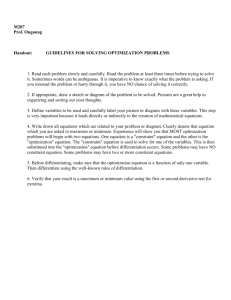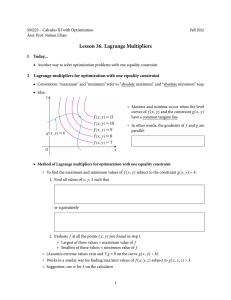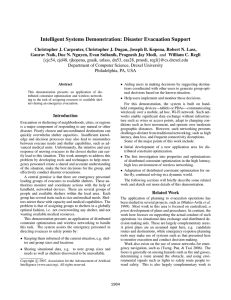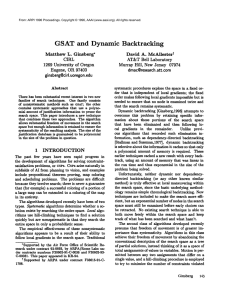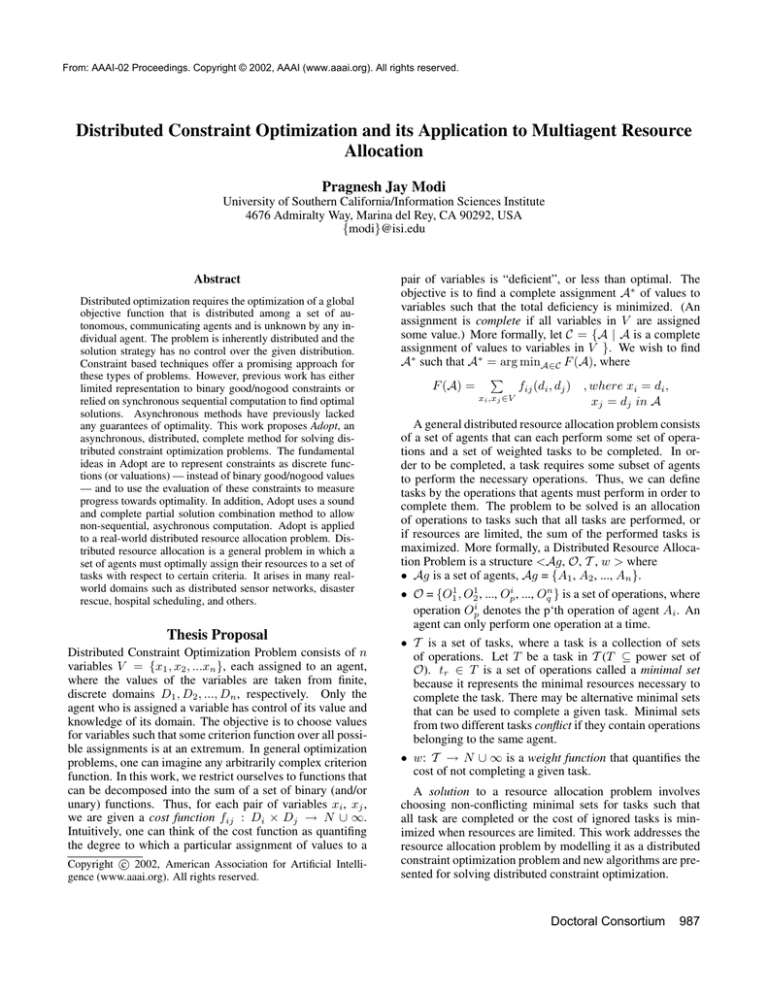
From: AAAI-02 Proceedings. Copyright © 2002, AAAI (www.aaai.org). All rights reserved.
Distributed Constraint Optimization and its Application to Multiagent Resource
Allocation
Pragnesh Jay Modi
University of Southern California/Information Sciences Institute
4676 Admiralty Way, Marina del Rey, CA 90292, USA
{modi}@isi.edu
Abstract
Distributed optimization requires the optimization of a global
objective function that is distributed among a set of autonomous, communicating agents and is unknown by any individual agent. The problem is inherently distributed and the
solution strategy has no control over the given distribution.
Constraint based techniques offer a promising approach for
these types of problems. However, previous work has either
limited representation to binary good/nogood constraints or
relied on synchronous sequential computation to find optimal
solutions. Asynchronous methods have previously lacked
any guarantees of optimality. This work proposes Adopt, an
asynchronous, distributed, complete method for solving distributed constraint optimization problems. The fundamental
ideas in Adopt are to represent constraints as discrete functions (or valuations) — instead of binary good/nogood values
— and to use the evaluation of these constraints to measure
progress towards optimality. In addition, Adopt uses a sound
and complete partial solution combination method to allow
non-sequential, asychronous computation. Adopt is applied
to a real-world distributed resource allocation problem. Distributed resource allocation is a general problem in which a
set of agents must optimally assign their resources to a set of
tasks with respect to certain criteria. It arises in many realworld domains such as distributed sensor networks, disaster
rescue, hospital scheduling, and others.
Thesis Proposal
Distributed Constraint Optimization Problem consists of n
variables V = {x1 , x2 , ...xn }, each assigned to an agent,
where the values of the variables are taken from finite,
discrete domains D1 , D2 , ..., Dn , respectively. Only the
agent who is assigned a variable has control of its value and
knowledge of its domain. The objective is to choose values
for variables such that some criterion function over all possible assignments is at an extremum. In general optimization
problems, one can imagine any arbitrarily complex criterion
function. In this work, we restrict ourselves to functions that
can be decomposed into the sum of a set of binary (and/or
unary) functions. Thus, for each pair of variables xi , xj ,
we are given a cost function fij : Di × Dj → N ∪ ∞.
Intuitively, one can think of the cost function as quantifing
the degree to which a particular assignment of values to a
c 2002, American Association for Artificial IntelliCopyright gence (www.aaai.org). All rights reserved.
pair of variables is “deficient”, or less than optimal. The
objective is to find a complete assignment A∗ of values to
variables such that the total deficiency is minimized. (An
assignment is complete if all variables in V are assigned
some value.) More formally, let C = {A | A is a complete
assignment of values to variables in V }. We wish to find
A∗ such that A∗ = arg minA∈C F (A), where
F (A) =
fij (di , dj ) , where xi = di ,
xi ,xj ∈V
xj = dj in A
A general distributed resource allocation problem consists
of a set of agents that can each perform some set of operations and a set of weighted tasks to be completed. In order to be completed, a task requires some subset of agents
to perform the necessary operations. Thus, we can define
tasks by the operations that agents must perform in order to
complete them. The problem to be solved is an allocation
of operations to tasks such that all tasks are performed, or
if resources are limited, the sum of the performed tasks is
maximized. More formally, a Distributed Resource Allocation Problem is a structure <Ag, O, T , w > where
• Ag is a set of agents, Ag = {A1 , A2 , ..., An }.
• O = {O11 , O21 , ..., Opi , ..., Oqn } is a set of operations, where
operation Opi denotes the p‘th operation of agent Ai . An
agent can only perform one operation at a time.
• T is a set of tasks, where a task is a collection of sets
of operations. Let T be a task in T (T ⊆ power set of
O). tr ∈ T is a set of operations called a minimal set
because it represents the minimal resources necessary to
complete the task. There may be alternative minimal sets
that can be used to complete a given task. Minimal sets
from two different tasks conflict if they contain operations
belonging to the same agent.
• w: T → N ∪ ∞ is a weight function that quantifies the
cost of not completing a given task.
A solution to a resource allocation problem involves
choosing non-conflicting minimal sets for tasks such that
all task are completed or the cost of ignored tasks is minimized when resources are limited. This work addresses the
resource allocation problem by modelling it as a distributed
constraint optimization problem and new algorithms are presented for solving distributed constraint optimization.
Doctoral Consortium
987

